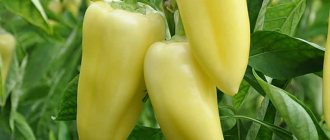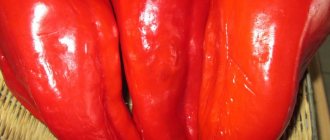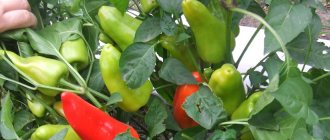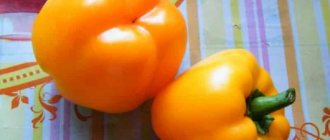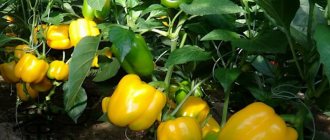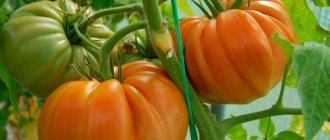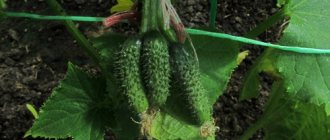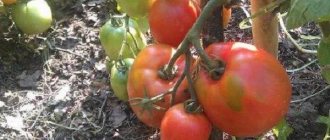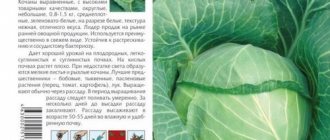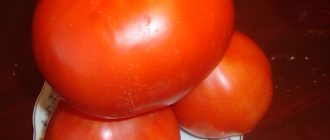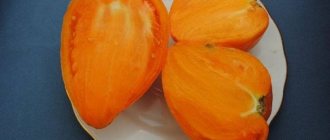Advantages and disadvantages
The blot variety has a number of advantages that provide it with a worthy place along with proven varieties of pepper:
- ease of cultivation;
- relative ease of care;
- availability of vaccinations against various infections;
- high yield, reaching 4 kg per square meter (up to 11 fruits per plant);
- appearance and pleasant taste of the fruit.
At the same time, it is worth remembering that growing the variety involves certain conditions. Like all peppers, the type of soil and the presence of fertilizers matter for the blot variety. Fruit growth and ripening also depend on the availability of heat and light.
The only significant drawback that all new varieties suffer from is the high cost of seeds.
For reference. Although breeders classify the Klyaksa pepper as universal, its fruits are best used in salads. During heat treatment, they lose their color, acquiring a dirty green color, so they are not recommended for use in canned foods and hot dishes.
Pros:
- excellent taste;
- high productivity;
- beautiful bright fruits;
- transportability;
- resistance to temperature changes.
Minuses:
General characteristics of the variety
Bluebell is described as a bitter perennial variety. In fact, this description is not true enough. Its taste is moderately spicy. It is distinguished by a piquant-spicy aroma. The appearance of the bushes and fruits has significant differences from the usual varieties of pepper.
Bluebell is a spreading variety. The bushes reach a height of 2 meters. The stems are powerful. The leaves are small. The stem of the plant and its leaves are covered with small fluff. The fruits have an unusual shape, resembling a bell or an elongated squash. The weight of the fruit reaches 75 grams. The pulp is juicy and fleshy. When ripe, the pods are red. The bright color and long stalks add decorative appeal to the plant.
Bellflower is a late-ripening variety. Biological maturity of fruits occurs 140-150 days after the appearance of seedlings.
The fruits have an unusual taste. They do not have a burning pungency. The taste of the fruit is heterogeneous. In the immediate vicinity of the stalk it is moderately sharp. Pepper petals have a sweetish, spicy taste with light fruity notes. Some gardeners note the lemon flavor. Peppers become hot after reaching technical maturity.
The bell is used for fresh consumption and canning. It is actively added to sauces and stews.
Description and characteristics of the variety
Bell pepper Purple Bell can be planted in open ground, and in cold areas - in film greenhouses. The variety is tolerant to temperature changes. Seeds are sold by “Search” and “Johnsons”.
Black pepper bush Purple bell of medium height. The ripening period is late - after full germination, 120-130 days pass before harvesting. The fruits are drooping, large to very large. The average weight is 110-165 g, but there are peppers up to 200 g. The shape is cuboid. At maturity, the color is deep purple or with a purple tint. The thickness of the walls reaches 7-9 mm. The pulp has a strong pleasant aroma and is sweet.
The interesting color of the vegetable allows it to be used in any dish, but after heat treatment it loses its brightness and can turn dark gray.
Rules for obtaining healthy seedlings
There is a proven method to determine the quality of planting material. It allows you to significantly save time due to the absence of the need to try to produce seedlings from obviously empty or spoiled seeds. To do this, they are placed in a saline solution for 10-15 minutes, selecting only those that will remain at the bottom of the container after the expiration of the period.
For disinfection, it is recommended to keep the seeds in a concentrated solution of manganese for 20 minutes. To get the first shoots faster, the seeds can be soaked in a biogrowth stimulator, and to protect them from pests they are additionally treated with fungicides.
The second important component when obtaining seedlings is the quality of the soil. When choosing it, the following qualities are especially valued:
- fertility;
- looseness;
- ability to pass air and moisture.
To increase these indicators for ordinary soil, organic fertilizers and sand are added to it. Amateur gardeners who prefer ready-made soils from the store should choose specialized complexes and carefully read the composition.
If you plan to plant peppers in the ground already in mid-spring, you need to start planting seeds in February. To do this, take a container, the bottom of which is covered with a layer of slightly moistened soil. Then the selected seeds are planted at a distance of several cm from each other, after which they are covered with a layer of earth. For more comfortable development of seedlings, some use plastic cups instead of a common container.
Important. The optimal temperature for seedlings is 25 degrees. The second prerequisite will be a sufficient amount of light.
If all technologies are followed, you can expect the first shoots to appear within a week. The seedlings will be ready for planting in the ground in about a month and a half. But you shouldn’t do this before May 20th.
You may be interested in:
To ensure optimal development of the root system, a distance of 45 cm between plants and 30 cm between beds is required. When deciding whether to use greenhouse conditions or not, you should focus on weather conditions.
If the temperature at night is not expected to drop below 14 degrees, then it is quite possible to leave the pepper in the open ground. If frosts are still expected at night, it is worth additionally protecting young plants with a layer of film.
Some gardeners use the following method in planting peppers and other vegetable crops. While the sprouts are still small, they are completely covered with film. However, a cross-shaped cut is made in the covering opposite each plant. When the plant grows to the level of the film, its upper part freely passes upward, and the root system remains covered.
This approach allows you to achieve several points:
- the required temperature for the root system is ensured;
- moisture is retained;
- Uncomfortable conditions are created for weed growth.
The only disadvantage of this solution may be the inability to reuse the film.
How to grow seedlings at home
First of all, select the seeds. Sow the grains in fertile, loose soil. The seeds are pressed to the soil and covered with a layer of soil. There is no need to sprinkle too much soil on the grains; the seeds may simply not sprout.
Pots for seedlings can be of different diameters. The seedlings can be covered with film or glass. When the first shoots appear, watering is carried out only on the 3rd day. When condensation appears, the seedlings are ventilated.
In the phase of three true leaves, the Purple Bell pepper seedlings are picked and transplanted into separate pots. Picking is an important procedure that stimulates the growth of the root system and the development of lateral roots.
Do not leave plants to grow together in the same container. Young seedlings will soon begin to compete for light and water, as well as nutrients. Seedlings grown using the thickened method turn out to be frail, elongated, and non-viable.
To disinfect the soil before growing seedlings, treat it with Bordeaux mixture. For 1 bucket of Bordeaux mixture, take about 100g of copper sulfate. If mold appears on the surface of the soil, it must be removed immediately. Crops should not be thickened, otherwise the plants will begin to compete for light.
When growing seedlings on a windowsill, ventilate the seedlings and avoid overwatering. It is not advisable to use large containers for seedlings; the Purple Bell pepper has a slow developing root system. Remember that there should be no temperature changes or drafts in the room.
When 4 true leaves appear on the seedlings, drop the peppers into separate cups. The procedure for picking sweet peppers is mandatory.
60 days after planting the seeds in the soil, the seedlings should be in open ground or under film cover. It is also important to use fertilizing (2 will be enough).
Beneficial properties of pepper
Experts note the beneficial characteristics of the Bell variety. This is due to the high content of vitamins and microelements in the pulp of the plant’s fruits. Regular consumption of pepper minimizes the risk of heart attack and stroke. The beneficial properties of pepper are due to the high content of vitamins B and C.
Experts highlight several areas of beneficial effects of the Bell variety on the human body:
- removal of cholesterol;
- strengthening the nervous system;
- strengthening the bone corset;
- improving blood quality;
- increasing elasticity and strengthening blood vessels;
- memory improvement;
- stimulation of brain activity;
- improved vision.
Among the whole variety of purple peppers, as in other crops, you can find hybrids and varieties. And everyone has a difference in taste, shape, shades, yield. Making your choice is not an easy task! The most important thing in this matter is to listen to the opinions of experienced gardeners. And taking into account all the recommendations of avid summer residents, this selection of the most popular varieties was created.
Care instructions
For the Klyaksa pepper, as for other vegetable plants, the following important points in care are:
- watering;
- loosening;
- weeding;
- fertilizer.
When caring for peppers, you need to be attentive to the amount of moisture. The plant does not tolerate drought, but excessive watering is also undesirable for it. After moistening the soil naturally or artificially, the next necessary step is loosening. This simple action ensures better supply to the roots of water and air necessary for the normal functioning of the plant.
It is worth remembering that the root systems of peppers are close to the surface of the earth, so it is important to be especially careful not to damage them. The same goes for the weed removal process.
The first feeding of pepper is carried out approximately 10 days after planting in the ground. In total, this operation should be performed three times during the season. To do this, you should prefer organic fertilizers, in particular slurry.
Fact. A special feature of caring for blot pepper is the formation of a bush. If left to chance, the plant may become too large and the harvest will be delayed.
Given this feature, experienced gardeners advise removing the growing point when the main shoot reaches 25 cm. You should not allow the side shoots to exceed the height of the main stem. They should also be removed, especially if their intensive growth is noticed.
Water with settled water, slightly heated. It is applied at the root. Frequency – as needed. When the seedlings take root in the area, after watering the soil is loosened for better ventilation of the roots.
Feed 3-4 times. It is recommended to use ready-made complexes and mineral fertilizers, and reduce organic matter to a minimum.
Expert opinion
Valentina Rareko
Editor-in-Chief of Repka.online. Experienced summer resident and gardener.
The Purple Bell bell pepper is especially good fresh. It has a very rich and pleasant taste that will not leave any vegetable lover indifferent. Gardeners are invariably satisfied with the planting.
Reviews from those who grew 0″ {amp}gt; Order by:Most recentTop scoreMost helpfulWorst score
Show more
- Everyone knows that peppers are delicate plants and take a very long time to recover from the slightest damage, so early replanting is a very stressful procedure for them. And also, he doesn’t particularly like: acidic soils, clay, peat, a large percentage of nitrogen.
- When growing, you should monitor the height of the seedling container; it should not exceed 15 cm, since peppers are sown at a greater depth than tomatoes.
- It is better to sow seeds in February, where the weather is warm - it is permissible to sow in January. Thus, large peppers that ripen in 140 - 155 days will have time to ripen by July.
- Do not use peat pots. Plastic ones are fine.
- As long as there is no sunlight, the first leaf will not come out, even with artificial supplementary lighting. It will remain like this for a whole month with cotyledons. And this affects the yield and quality of the fruit.
- The seeds need to be stimulated. Keep them for 15 - 25 minutes in ordinary water at a temperature of 53 ° C, and put them in a moistened gauze cloth and place them on a small plate for 40 - 60 minutes, and you can immediately sow.
- Before sowing, fill the container halfway with well-moistened soil, compact it with a teaspoon, distribute the seeds according to the calculation of 2 × 2 cm and sprinkle with soil to 5 - 6.5 cm. Seeds should be sown to a depth of 3.5 - 4 cm. Containers can be covered with film coverings or glass and placed in a warm place. It doesn't take long for the pepper to sprout.
- Seedlings should be stored at room temperature, warm, without placing them next to window glass on the windowsill. It is important to provide them with plenty of light without overheating in the sun.
- Although peppers are little susceptible to pests, if aphids attack, it is more effective to use biological products, but sometimes it is enough to treat them every 4 to 6 days with a soap solution or a slightly pink solution of potassium permanganate. To prevent aphids, it is recommended to plant peppers next to tomato beds.
- The following have a good effect in the form of biofuel: dry grass, unrotted compost, but not fresh manure, otherwise the pepper will intensively grow green mass.
- Forming 3 – 4 stems is quite enough.
- It is not recommended to plant hot varieties of peppers next to each other, otherwise sweet-purple varieties may acquire unnecessary bitterness due to cross-pollination.
Thus, purple varieties of peppers are more adapted to unfavorable weather and grow well both in the middle latitude and some varieties in the northern latitude. Each type is interesting both aesthetically and for its taste. It is also a real storehouse of vitamins and beneficial microelements for the human body.
Growing in open ground
An important point when planting bell pepper seedlings is that representatives of the nightshade family should not grow in this soil for the next four years.
In regions with warm climates, peppers can be grown without seedlings. Such plants have a stronger and more developed root system.
Pepper is very responsive to the addition of organic matter. Manure must be composted before being added to the soil, bird droppings must be dried and soaked for 10 hours before use.
Lack of moisture negatively affects the fruiting of tomatoes. An effective way to process crops is mulching. Under a layer of mulch, moisture does not evaporate as quickly.
It is recommended to pick fruits that are not fully ripe, at the stage of technical ripeness.
Planting seeds
Bluebells are grown by seedlings. Seeds are used for sowing. Gavrish seed material is available for sale. One package contains up to 15 seeds. The variety is late ripening. For this reason, seeds are sown for seedlings in the second half of February or the first ten days of March.
Planting is done in special containers with drainage holes. If there are no holes for draining water, they must be pierced. Pepper is sensitive to excess moisture. The containers are filled with a ready-made peat mixture or the soil is prepared independently.
Place 1-2 seeds in one container and sprinkle with a thin layer of earth. Seedling pots are covered with film until the first shoots appear. The optimal germination temperature is 23 degrees. In thickened plantings, peppers are planted at the stage of 2-3 true leaves. During transplantation, it is important not to damage the root system. Watering is carried out moderately, as necessary.
Seedlings should be grown indoors until the onset of stable heat. Before planting bushes in greenhouses or open ground, peppers are hardened. To do this, lower the night temperature to 13-15 degrees, and the day temperature to 17-18 degrees, respectively.
For planting seedlings, prepare loose, well-ventilated soil and boxes or peat pots. Sow 2-2.5 months before transplanting to a permanent bed. Before sowing, seeds are soaked in a weak solution of potassium permanganate.
Planting depth - no more than 1 cm. Germination temperature is 23-25, for seedling growth - 18-22 at night and up to 25 during the day. Bushes peak in the 2-leaf phase.
The planting pattern in the ground is 40 by 40 cm.
Reviews from gardeners
Although this type of pepper was bred and recognized relatively recently, summer residents, amateurs and professionals, became interested in it. The greatest difficulty, in their opinion, is preparing the soil and seeds. If you managed to successfully cope with this task, then further care does not present any particular difficulties. Experts in this field readily recommend it to beginners.
Inna, 35 years old. Vladimir
“All my family loves salads, so cucumbers, tomatoes, peppers and herbs are mandatory attributes in my summer cottage. For many years I planted regular bell peppers, but a few years ago I wanted to try something new. I bought Klyaksa pepper seeds. I was very intrigued by the purple fruits in the picture and wanted to grow such a miracle on my own plot.
Asya, 23 years old. Krasnodar city
“The idea of planting peppers in the garden arose purely by chance. The year before last I was looking for seeds in the store and became interested when I saw bags of Klyaksa pepper. I took it purely out of interest. I really wanted to know what would happen. Having found the necessary information, I got down to business. I sowed the seeds, prepared the seedlings, planted them in the ground, but did not take into account that the bushes needed to be formed.
Therefore, in the first year the harvest was modest. Although there were not many fruits, my husband and I really liked them. The next year I tried again, but without the same mistakes, and the result was not long in coming. Now the Klyaksa pepper is my favorite variety. I’ve already bought the seeds, and in February I’ll be preparing seedlings again. I’m interested in the opinion of housewives who have tried culinary masterpieces with this pepper.
Many were delighted by the unusual, elegant appearance of the salads, in which bright red or deep purple pepper slices were visible. But there were also unpleasant surprises. When cooked, the appearance of the vegetable becomes rather inconspicuous, but there are no reports that the loss of color somehow affects its taste.”
Let's summarize: despite its relatively short history, Klyaksa pepper has established itself as a high-quality variety, reliably protected from diseases and the most unpretentious variety for growing. Unusual fruits combined with decent yields have provided it with a worthy place among vegetable crops.
An early ripening variety of sweet pepper for growing in open ground and film shelters. The period from germination to the beginning of ripening is 96-104 days.
The bush is compact, low.
The fruits are drooping, cone-shaped, purple in color at the stage of technical maturity, dark cherry in color at the biological stage. The average fruit weight is 90-120 grams. Wall thickness 5-7 mm. The taste is good, sweet, without bitterness. These peppers are good fresh and canned.
The Big Papa sweet pepper blooms very beautifully - with blue flowers. The pepper leaves also have a slightly purple tint.
The variety is characterized by stable yield and disease resistance.
Productivity: 6.8 - 7.2 kg per 1 sq. m of planting (with proper agricultural technology).
Purple Bell
The sweet pepper variety Purple Bell is a medium-ripening variety. The popularity of the species is associated with the unusual external and taste properties of the fruit. Gardeners choose the Purple Bell variety because of its rich taste characteristics and the unusual, almost black color of the fruit.
The plant is intended for cultivation in outdoor conditions and in greenhouse structures; with the latter option, yield indicators and fruit size increase. When grown in open ground, the average height of the bushes reaches 70-80 cm. The advantage of the variety is considered to be resistance to tobacco mosaic and potato virus.
The advantage of the plant is its ability to withstand temperature changes and show high yields when grown in difficult climatic conditions. Cultivation is carried out using seedlings. The plant does not respond well to transplants, so when such work is carried out, the growth of shoots stops. From the time of germination until the first mature pepper appears, 75 to 80 days pass. The recommended planting pattern is 40 by 60 cm.
With the correct growing technique and following the basic growing rules, up to 8 kg of peppers can be harvested from 1 m2.
Pepper fruits reach a weight of up to 165 grams. Vegetables have a characteristic cuboid shape and are distinguished by their small wall thickness, which reaches 6 mm. The height and diameter parameters average 9 to 11 cm. A distinctive feature of the variety is the presence of a pronounced peppery taste, juiciness and aroma in vegetables. The fruits can be used fresh and for homemade preparations.
